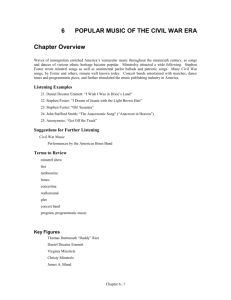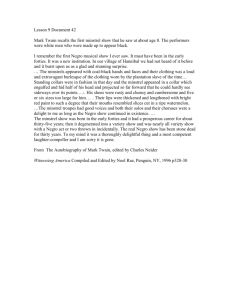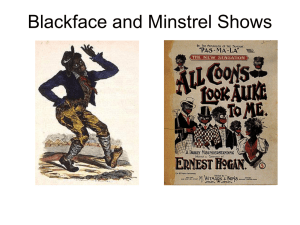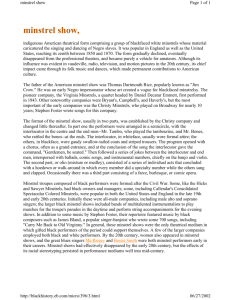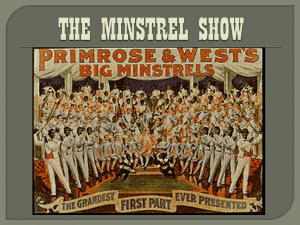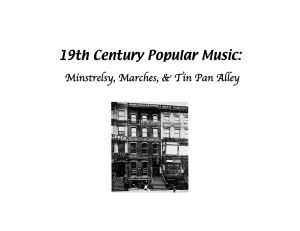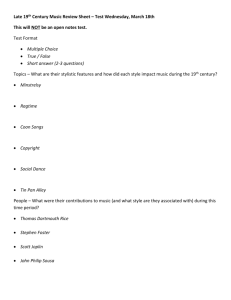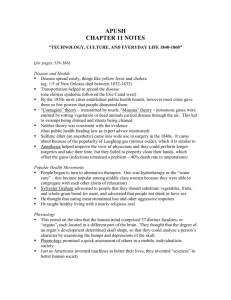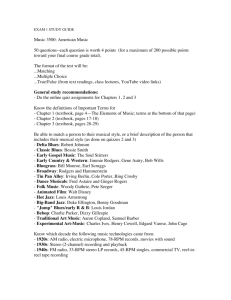From The Minstrel Mask
advertisement
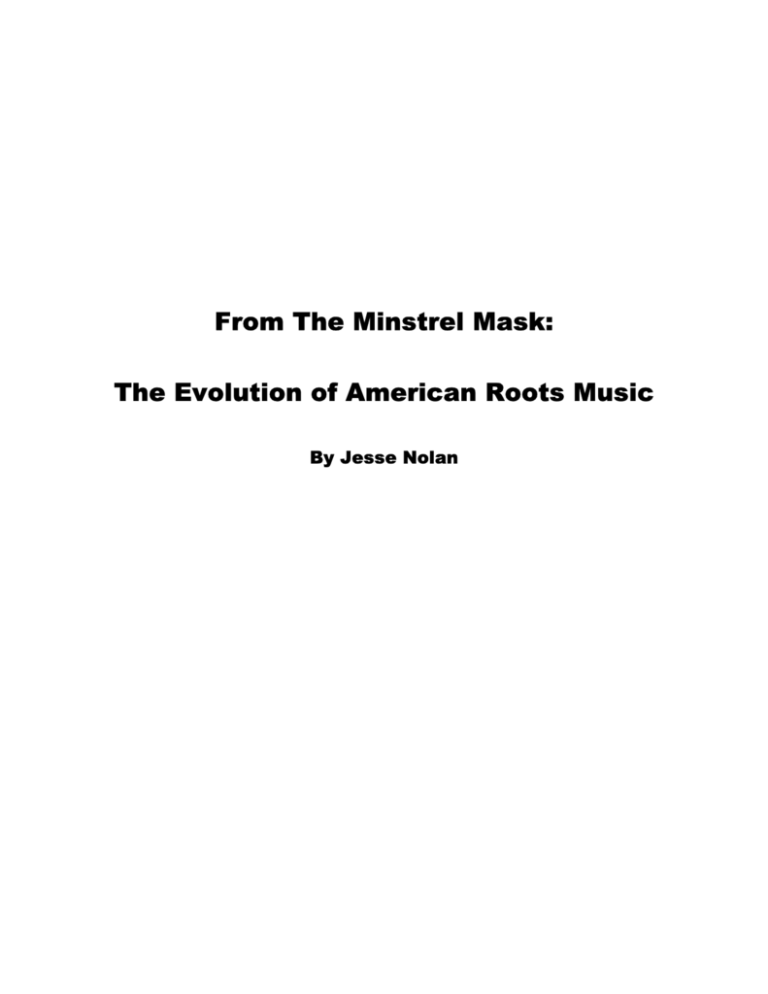
From The Minstrel Mask: The Evolution of American Roots Music By Jesse Nolan Jesse Nolan 1 From The Minstrel Mask: The Evolution of American Roots Music “You don’t need a weatherman to know which way the wind blows” -Bob Dylan, “Subterranean Homesick Blues” (1967) Music has an innate sense of direction. Its path is self-guided and its journey beautiful. It needs no weatherman. Much like the winds that have crisscrossed America since the days of roaming buffalo, from the rocky shores of the Atlantic to the snowcapped Rocky Mountains, the breath that is music has blown its gales upon the sails of evolution, charting a dynamic course through the waters of American popular culture. Beginning in its infancy at the dawn of the nineteenth century as a young America boasted the promise of prosperity, American popular culture began searching for a unique face all its own. Little did she know, America would find this face in a champagne bottle. Using burnt champagne cork and water as makeup, early American entertainers began “blacking-up” their faces and caricaturizing the stereotypical demeanor of southern plantation slaves. These performances, originating circa 1820, became known as “minstrel” shows and represented the “first original theatrical form created in America.”1 As minstrel shows grew in popularity, the content became more refined, until a standard repertoire of songs, dances, and comedic sketches emerged in the pre-Civil War years. The style of entertainment known as minstrelsy, which rose to popularity in the later half of the nineteenth and early twentieth century and was characterized by the striking image of performers in blackface, provided the musical wind that has propelled the history of American roots music, including country, bluegrass, folk, and rock ‘n’ roll, for over a century. 1 Chuck Mancuso, Popular Music and The Underground. (Dubuque, Iowa: Kendall/Hunt Publishing. 1996), 20. Jesse Nolan 2 The Rise of the American Minstrel Show From the moment Thomas Dartmouth Rice (a.k.a. “Daddy” Rice), blacked-up his white face with a mixture of burnt cork and water and performed “Jump Jim Crow” circa 1830, a new form of popular entertainment was born. Rice claimed to have learned the routine from an elderly black stable worker in the south who sang the lines “Weel about and turn about and do jus so, eb'ry time I weel about I jump Jim Crow"2 while dancing with floppy arms and legs. Although the location of the original T.D. Rice performance remains a point of debate – scholars have placed it anywhere from New York to Louisville to London – what remains a certainty is that “Daddy” Rice’s routine, for the first time, portrayed Black American culture, or at least the white view of Black America, on the American stage. In the years that preceded the Civil War, “the minstrel show, which featured ‘shuffling, irresponsible, wide-grinning, loud-laughing Negroes’ in a musical rendition of ‘darky life on the Old Plantation,’ became one of the most popular entertainments in nineteenth-century America.” 3 These “negroes,” actually white men with their faces painted in a thick black paste, took to the stage in the late 1820s “performing alleged Negro songs and dances in circuses and between the acts of plays,” 4 a similar phenomenon that spawned the beginnings of opera buffa in Europe. It was not until a group of white men in blackface arrived in New York City in February of 1843 that minstrelsy became an American popular institution. 2 PBS Website, www.pbs.org Allen Woll, Black Musical Theatre: From Coontown to Dreamgirls (Baton Rouge: Louisiana State University Press, 1989), 1. 4 Robert C. Toll, Blacking Up (New York: Oxford University Press, 1974), 27. 3 Jesse Nolan 3 The Virginia Minstrels, comprised of four out of work entertainers, namely Dan Emmett (1815-1904), Billy Whitlock, Frank Pelham, and Frank Brower, had assembled a show consisting entirely of minstrel songs and comedic sketches performed entirely in blackface. In their desperate attempt to recover from the harsh 1842-43 entertainment season by creating an original, entertaining show, they became instant sensations. In the year that followed, minstrel shows swept the nation playing in New York, Baltimore, Louisville, Savannah, Mobile, Memphis, New Orleans, Charleston, and Washington D.C. as a private performance for President John Tyler. 5 Out of this popularity, minstrel troupes began to form all over the country. Among these were E.P. Christy’s Minstrels and Wood’s Minstrels in New York, Sanford’s Minstrels and Carncross & Dixey’s Minstrels in Philadelphia, and The Buckley Serenaders. These troupes “generally played the second-class burlesque houses, so patrons of the legitimate theatre did not usually frequent these performances.” 6 Minstrelsy, however, was about to become the form of popular entertainment and reach the so-called “legitimate theatre” as tensions surrounding what would be the outbreak of the Civil War mounted in the 1850s. Since the content derivation of minstrel shows was grounded in racial stereotypes of African-Americans, it is of no surprise during the slavery debate of the 1850s-60s that threatened to destroy the Union, and upon the coattails of Harriet Beecher Stowe’s 1852 novel Uncle Tom’s Cabin and it’s outcry against slavery, that minstrel shows came to be the “vehicle through which its primarily Northern, urban audiences could work out their feelings about even the most sensitive and volatile issues.” 7 In order to remain a popular entertainment form, however, the troupes changed the content of their shows as public 5 Robert C. Toll, 31. Allen Woll,, 2. 7 Robert C. Toll, 65. 6 Jesse Nolan 4 opinion shifted. This phenomenon is illustrated best by Robert C. Toll in Blacking Up when he describes the content of pre-1850s minstrel shows as containing “both positive images of happy plantation blacks and negative condemnations of the cruelty and inhumanity of slavery.” This contrasts sharply with the pre-Civil War (1850s-1860s) minstrel show content of “contrasting caricatures of contented slaves and unhappy free Negroes.”8 Thus, the change allowed Northerners to place aside the atrocities of slavery in order to avoid radical change that would destroy the United States of America. As the politically charged atmosphere of America found its outlet in minstrel shows, they rose to unequalled popularity, with touring troupes such as Christy’s Minstrel canvassing the country, and with minstrel shows finally reaching Broadway audiences circa 1890. The end of the Civil War ushered in perhaps the most ironic image of the minstrel stage: black performers in blackface. Since the late 1840s, African-Americans had began to don blackface and take to the minstrel stage in predominantly white troupes, but it was not until the post-Civil War years that all black minstrel troupes began to emerge. Although it seems entirely hypocritical that black performers would appear in a production that unabashedly degraded their race, it makes perfect sense at the same time. Blacks were making fun of whites making fun of them. No strangers to parody, southern blacks had donned “whiteface” in the years preceding the Civil War, when circa 1840 a dance known as the “cakewalk” emerged in which slaves parodied the formal dances of their masters. The cakewalk would eventually make its way into the ensemble finale of minstrel shows. Secondly, black entertainers performed in blackface because it was the only way African-Americans were allowed to take the stage, both during slavery and in the Jim Crow years that followed the Civil War. Artist Michael Thomas Ray explains 8 Robert C. Toll, 70. Jesse Nolan 5 this in his essay About Blackface when he states, “blacking up was once a prerequisite for performers and an unequivocal symbol of white dominance for African-Americans.” 9 Formed in 1865, one of the first major black minstrel troupes was Brooker and Clayton’s Georgia Minstrels who billed themselves as "The Only Simon Pure Negro Troupe in the World." 10 The image of a black man in blackface is a powerful one that “has undoubtedly influenced the future of popular entertainment forever.” 11 With both white and black entertainers participating in blackface entertainment the stage was set for a musical revolution. Music of the Minstrel Stage Although white blackface performers such as T.D. Rice, George Washington Dixon, and J.W. Sweeny claimed their material to be “black” in origin, the melodies of most early minstrel songs were derived from British folk tunes. The lyrics, however, were original, and they often caricaturized black dialogue, as in “Jump Jim Crow.” Even the facial expressions, body movements, dance steps, dress, and dialect were highly exaggerated imitations, if one could even call them that, of African-Americans. These songs, coupled with their signature dances, became known as “coon” songs. “As a genre of lyric grotesquing black sensibilities,” coon songs provided the material for the original minstrel shows of the 1830s. Ironically, however, the song that gave the genre its name as it is known today was not written until the nineteenth century neared its end. “All Coons Look Like Me,” written by a black comedian named Ernest Hogan, who was born Reuben Crowder, was “imbued with the new musical spirit and 9 Michael Thomas Ray, About Blackface. Bamboozled Website, www.bamboozledmovie.com Bamboozled Website, www.bamboozledmovie.com. 11 Ibid. 10 Jesse Nolan 6 style of syncopation.” 12 With the forming of minstrel troupes such as the Virginia Minstrels and the rise to popularity of blackface entertainment, the shows became organized into a format that lasted until minstrelsy’s end. Most minstrel shows followed the same three part format. During the introduction an “Interlocutor,” who served as the Emcee, would emerge first, often standing in the middle of the stage, surrounded by other men in blackface. Two of these men, Mr. Tambo and Mr. Bones, who played the tambourine and bone-like castanets respectively, were known as the “end men” because they sat on opposite sides of the Interlocutor. Tambo and Bones eventually became stock characters in the minstrel tradition. The Interlocutor, who was portrayed as a dignified, intelligent man with a superior vocabulary, would begin by welcoming the audience and then turn his attention to Tambo and Bones. The end men, dressed in bright colors and wearing dark burnt cork masks and red makeup on their lips to give the appearance of huge eyes and a gaping mouth, would then initiate a series of jokes and songs consisting of “ludicrous dialect,” puns, and heavy, exaggerated accents. During these skits, emphasis was placed on the “’darky’ as comic buffoon (a happy go-lucky, chicken-stealin’, foot-shufflin’ ignoramus who was lazy but over-sexed.)”13 The following is an example of a traditional minstrel show introduction, excerpted from a minstrel songbook written in the vain of the Virginia Minstrels shows, and published in 1950: WHITLOCK (INTERLOCUTOR): Gentleman, be seated! BONES: W: B: W: 12 13 Mr. Whitlock Yes, Mr. Bones! Ah understand yo’s a very smart man – a very, very smart man. (With becoming modesty) Oh, now, Mr. Bones, I wouldn’t go so far as to say Nick Tosches, Where Dead Voices Gather. (New York: Little, Brown and Company, 2001), 183. Chuck Mancuso, 20. Jesse Nolan B: W: B: W: B: W: B: W: B: W: B: W: B: W: B: W: B: W: B: 7 that. My cerebellum and cranium have possibly been impregnated with the a modicum of intelligence. (Blinking his eyes) Sez which? I believe I know as much as the average man. Well, my average ain’t so high, so maybe yo’ all can tell me somethin’ Ah wants to know. I’ll be glad to enlighten you, if I can. Ah don’t want to git “lightened.” Ah jes’ wants to know somethin’. Very well, Mr. Bones. What do you want to know? What is the meanin’ of de word abbreviation? That’s an easy one. Abbreviation means to take something long and cut it short. Dat’s what Ah though. Well, do remember dat ole hound dog of mine? Yes, I do. Does you remember what a long tail dat dog had? Yes, come to think of it, your dog had an exceptionally long tail. Longest tail Ah ever seen on a dog. Well, what’s that got to do with the meaning of the word abbreviation? A whole lot. Last week, mah dog was runnin’ across de railroad track, waggin’ dat long long tail. Long come a train and cut off mah dog’s tail. My! My! How sad! Now the poor dog hasn’t got a tail to wag. (Sadly) Dat’s right. He got no tail to wag. Well, how can you tell when he’s happy about something? He wags his abbreviation. 14 Another popular topic of the introduction was women. INTERLOCUTOR: TAMBO: I: T: I: T: I: T: I: I: T: I: Tambo, do you know why widows get married so easily? ‘Cause dead men tell no tales. Why is it they call the groom’s attendant the best man? Well, he’s the best off, ain’t he. Does a man take a woman for better or worse? I don’t know much about the woman, but I know the man will get the worst of it. Why is it the woman takes the name of the man she marries? Well, she takes everything else, so she might as well take that, too. Mr. Tambo, what kind of woman did you marry? I married a regular umpire. Your wife is an umpire. Yessuh, my wife is just like the regular Big League Baseball umpire, she never thinks I’m safe when I’m out.15 After the invention of audio recording, the tradition of combining jokes and songs was put on record by a yodeling blackface minstrel singer named Emmett Miller (19001962) in his songs for Okeh records. Particularly of note is the song “I Ain’t Got 14 Charles George, Minstrel Parade: A Complete Minstrel Revue. (Minneapolis: T.S. Dennison & Company, 1950.), 23-24. 15 Dailey Paskman, Blackface and Music: A New Minstrel Folio. (New York: Edward B. Marks Music Corporation. 1986), 10. Jesse Nolan 8 Nobody,” recorded in 1928 on Okeh 41438 in which Miller, posing as the ignorant Sam, talks to a friend about losing his wife. The punch-line: FRIEND: SAM: Did she leave you much? ‘Bout twice a week. It is also interesting to acknowledge that Emmett Millet’s backup band, known as the Georgia Crackers on most of his recordings, was none other than a smaller version of the Dorsey Brothers’ band. It was during the introduction of a minstrel show that a singer like Emmett Miller would have been featured. Following the Interlocutor’s greeting and the Tambo and Bones skit, the Interlocutor would introduce a singer, normally a tenor, but in Miller’s case, “the man with the clarinet voice,” to sing a popular ballad or song of the day. The second section was called the Olio, which featured a variety of acts including songs, dances, animal acts, instrumental performances, or parodies of well known plays. “This portion of the show became the basis of the vaudeville show of the first three decades of the twentieth century and future television variety shows (such as that hosted by Ed Sullivan).” 16 It was during this section that a performance like “Jump Jim Crow,” the famous “Daddy” Rice routine would be staged. Aside from the variety of acts strewn throughout the Olio, its staple was know as the “stump” speech, in which one of the end men, Tambo or Bones, would proceed to give a “serious” discourse employing plenty of ignorance and “nigger” dialogue: Feller-fellers and oder fellers, when Joan of Ark and his broder Noah’s Ark crossed de Rubicund in search of Decamoran’s horn, and meeting dat solitary horseman by de way, dey anapulated in de clarion tones if de clamorous rooster, de insignification of de – de – de – de hop-toad am a very big bird – du da – du da day – does it not prove dat where gold is up to a discount of two cups of coffee on de dollar, dat bolivers must fall back into de radience of de – de – anything else, 16 Chuck Mancuso, 20. Jesse Nolan 9 derefore at once and exclusively proving de fact dat de afore-mentioned accounts for de milk in de cocoa-nut!17 Speaking of “doo dah,” one of the most popular and familiar songs of the minstrel stage (and beyond) was “De Camptown Races,” written by “America’s First Great Song Writer,” Stephen Foster. Foster (1826-1864), a budding composer who sought fame in his ballads, was embarrassed when his songs “Oh! Susanna” (1948), “De Camptown Races” (1850), and “Swannee River” (1851) became associated with minstrelsy. Although they were the songs that eventually made him famous, Foster decided to sell (cheaply) many of his minstrel songs to companies such as E.P. Christy’s Minstrels.18 Foster’s songs, along with the music of W.C. Handy (1873-1958) and the famous dance “the cakewalk”, were routinely featured in the ensemble finale of minstrel shows, which drew the production to a close with its one-act skit often set on Southern plantations or in a watermelon patch. Handy, the so-called “Father of The Blues,” wrote “St. Louis Blues,” a song that became a favorite of minstrel singers. Before writing his signature song, Handy performed in a blackface minstrel troupe from 1896-1903. Emmett Miller’s countrified rendition of the song recorded in 1928, complete with yodeling, along with his “Lovesick Blues” (1928), would soon influence some of the most important musicians in the history of country and roots music. 17 18 Robert C. Toll, 55. Chuck Mancuso, 22. Jesse Nolan 10 Influence on American Popular Music “The real history of minstrelsy in this country, were it to be honestly and comprehensively written, would touch in one way or another every form of popular music we have and on some part of our composed tradition.” 19 Robert Cantwell’s words, although general, speak not only of the durability of minstrel music, but also fortify the permeation of minstrel philosophy and ideology in American popular music. The category “popular music,” although a vast chasm of endlessness, represents music not defined as “art” music, into which “classical” music and to some extent jazz have now been herded. The addition of the word “American,” however, introduces a new category; a category which began with blackface minstrelsy. Just as the music of Bach, Mozart, and Beethoven became European popular music, so too had minstrelsy rose to this stature in nineteenth and early twentieth century America. And just as the music of these great European masters generated the steady wind of progress from which the “classical” cannon has evolved, so too has minstrelsy created “that wind, that American grain…to which we are heir.” 20 That “Old Southern Sound” Beginning with that “Old Southern Sound,” the music of the minstrel stage has influenced countless early country and roots derivatives. Uncle Dave Macon (18701952), one of the earliest and most influential country musicians, played and recorded “coon” songs for Okeh records between 1927-29 as “minstrelsy went to its grave” and 19 Robert Cantwell, Bluegrass Breakdown: The Making of that Old Southern Sound (Urbana: University of Illinois Press, 1984), 257. 20 Nick Tosches, Where Dead Voices Gather. 200. Jesse Nolan 11 “country music became the last bastion for coon song.” These songs included “The Coon That Had the Razor” and “Run, Nigger, Run,” a song also recorded by the country musicians Fiddlin’ John Carson and Dr. Humphrey Bate’s Possum Hunters.21 Macon simply reworked the songs of the minstrel stage to fit his country banjo style; a style that would garner him immense popularity on radio in 1925 and eventually earn him a music festival named in his honor that would draw forty thousand fans to Mufreesboro, Tennessee. Uncle Dave was also no stranger to showmanship. Becoming one of the first stars of the Grand Ole Opry, Macon amused audiences with his minstrel-like antics of dancing, high kicking, throwing his banjo in the air, or passing it between his legs, all while playing his signature song “Go ‘Long Mule.” Like the entertainers of minstrelsy, Uncle Dave was a larger-than-life myth. He knew every button to punch to make us all like him. And, as it is with a showman, there was a lot of pizzazz there – there was a lot of poof and blow dust, and woofle dust, as according to Uncle Dave himself. But hey, that’s why we go to show’s in the first place. We want a little woofle dust on us.22 Uncle Dave Macon was simply a derivative, a manifestation of blackface minstrelsy without the burnt cork, but a minstrel nonetheless; a white man singing the same songs and dancing the same dances that his blackface contemporaries had made popular throughout America. Among the most popular and famous musicians during the early days of country music, no one has been more influential on modern American roots musicians than the yodeling blues-country singer Jimmie Rodgers. Rodgers (1897-1933), who rode to popularity on the back of a white blues called “Blue Yodel,” became one of the first country musicians to sell over one million records. He was also no stranger to blackface 21 Nick Tosches, Where Dead Voices Gather, 181. Robert Santelli; George-Warren Holly; Jim Brown, American Roots Music. (New York: Harry N. Abrams, Inc., 2001), 16. 22 Jesse Nolan 12 performance. In fact, Rodgers appeared in blackface during the 1924-25 entertainment season in a traveling medicine show, a cousin of the minstrel show. That same year, a song titled “He’s In The Jailhouse Now,” later recorded in 1928 by Rodgers as “In the Jailhouse Now,” was popularized by Rody Jordan of the Al G. Field’s Minstrels.23 This 1928 recording of the song along with his country laments such as “Treasures Untold” and “My Old Pal” catapulted Rodgers to stardom, becoming the single best-selling artist in country music during the years of the Great Depression. His music, characterized by simple, rhythmic guitar strumming featured a high falsetto yodel that Rodgers broke into with incredible ease. The yodel, although not unique to the music of Jimmie Rodgers, as its roots can be traced to early eighteenth century British stage shows, was his signature; a defining stylistic trait that he inherited from the minstrel tradition. From its inception into American minstrelsy in 1847 by the blackface minstrel Tom Christian, to its establishment as a routine aspect of blackface performance by “The Yodeling Minstrel” Al Tint, yodeling carved a path through minstrel performances, landing on Jimmie Rodgers’ doorstep through the music of a blackface performer named Emmett Miller.24 Emmett Miller (1900-1962), one of the greatest musicians of the minstrel stage was known throughout the touring blackface circuit as the “Famous Yodeling Blues Singer” and was billed as such in 1926, while Jimmie Rodgers, racked by the tuberculosis he had contracted in 1924, was struggling to get by as a musician in an Asheville, North Carolina string band. Although it is not known whether Rodgers and Miller ever met, it is agreed upon by music scholars that Rodgers fashioned his yodel from Miller’s 23 24 Nick Tosches, Where Dead Voices Gather, 66. Nick Tosches, Country: The Twisted Roots of Rock ‘n’ Roll. (New York: Da Capo Press, 1977), 109. Jesse Nolan 13 recordings of songs such as “Lovesick Blues” (recorded for Okeh by Miller in 1925); a song that would also have a profound influence on another famous country musician, Hank Williams.25 “It was Miller who cultivated it (yodeling) as something plaintive and disarming, something that would become – in Jimmie Rodgers’ “Blue Yodel” (1927)…and in the yodeling of Hank Williams and Jerry Lee Lewis – an expressiveness pure and free.” 26 The bequeathing of the yodel from Miller to Rodgers, from minstrel song to popular country music, becomes entirely lucid after listening to recordings of both musicians. In the same fashion by which Uncle Dave Macon adapted coon songs and minstrel antics to his country banjo music, so too had Rodgers stylized the longstanding minstrel tradition of yodeling and sewn it into the fabric of country music. Crowned with the title “The Father of Country Music,” Jimmie Rodgers was the first inductee into the Country Music Hall of Fame in 1961. Cowboys & Bluegrass The torch of country music had been sparked by the music of Uncle Dave Macon and the flame nurtured by the country yodeler Jimmie Rodgers and his “Blue Yodel”; but after Rodgers’ untimely death at the age of 36, the flame that had burned so bright needed caretakers. The torch found solace in the hands of a yodeling cowboy name Orvon Gene Autry (1907-1998) and a “lovesick” hillbilly named Hank Williams (1923-1953). Autry, like Rodgers had also performed in blackface in a traveling medicine show early in his career. He began his recording career as Gene Autry, sans first name, with Victor in 25 26 Nick Tosches, Where Dead Voices Gather. Ibid., 65. Jesse Nolan 14 1929, “often specializing in imitations of Jimmie Rodgers and off-color white blues.” 27 His biggest hit, recorded in 1931, was “That Silver-Haired Daddy of Mine.” Through these imitations of Rodgers, Autry became known as “The Oklahoma Yodeling Cowboy,” employing the same wistful yodel wrought by Emmett Miller on the minstrel stage. Autry was also one of the first country musicians to have his music published. Gene Autry’s Sensational Collection of Famous Original Cowboy Songs and Mountain Ballads was published in 1932 and included 30 Autry songs like “That Silver Haired Daddy of Mine” and “I’ll Be Thinking of You Little Gal.” The original cover of the book features the words “yodel arrangements” beneath the title. When Hollywood got wind of Autry’s success he became the first country musician to appear in movies. Although they were low budget “B” western movies, this opportunity provided Autry with another outlet to introduce some of his most popular songs to the American public. An imitator of Jimmie Rodgers, Hank Williams also found the fabric of his music in the minstrel tradition. Williams, also a famous yodeler, recorded a version of Emmett Millers “Lovesick Blues” in 1948 (released January 1949). “It is likely that this (Miller’s) version of ‘Lovesick Blues,’ coupled in its release with ‘I Ain’t Got Nobody,’” a song that would be recorded thousands of times by jazz, country, blues, and folk artists, “became the direct inspiration for the 1948 performance that twenty-five-year-old Hank Williams rode to fame. "28 Written by a Tin Pan Alley songster Cliff Friend, with lyrics penned by Irving Mills, “Lovesick Blues” became one of country music’s most enduring and popular songs after Williams performed it for his debut at the “Grand Ole Opry” on June 11, 1949. As Hank strummed his final chord the audience began cheering so wildly 27 28 Robert Santelli; George-Warren Holly; Jim Brown, 26. Nick Tosches, Where Dead Voices Gather, 146. Jesse Nolan 15 that Williams had to perform six encores. His music would go on to inspire Tony Bennett, whose 1951 cover of Williams’ “Cold, Cold Heart” would earn him a Number One hit. Following suit, Rosemary Clooney recorded a version of Hank’s “Half as Much” in 1959, scoring her a Number Two spot atop the pop charts. The most recent cover of a Williams song, however, was done by none other than multi-Grammy award winning artist Nora Jones on her 2002 debut release Come Away With Me. But if it had not been for the music and inspiration provided to Williams by the tradition of minstrel music, none of this would have been possible; and thus the wind of minstrelsy kept propelling the evolution of American popular music. Although by the 1940s minstrel shows were practically buried amidst the heyday of jazz, their legacy was nourished in the performances of Bill Monroe (1911-1996). Monroe, a country contemporary of Hank Williams, was influenced so deeply by minstrel performance that his shows even featured a segment in which he performed entirely in blackface. During these performances, Monroe combined the country sound of Jimmie Rodgers with the string band movement that was catalyzed by the birth of the guitar; an instrument derived from its cousin, the banjo, a staple of the minstrel stage. This combination birthed a new style of country music known as “bluegrass.” Monroe is perhaps “the only musician who can claim to have single-handedly spearheaded an entire genre of country music.” 29 Monroe influenced Elvis Aron Presley to record “Blue Moon of Kentucky,” a Bill Monroe song from 1945, on the flip side of his first record. Monroe’s shadow (along with that of Jimmie Rodgers) even made an appearance on the rock ‘n’ roll charts of 1960 when the Fendermen recorded a version of the 1940 Monroe classic “Mule Skinner Blues,” which was originally recorded by Jimmie Rodgers as 29 Country Music Hall of Fame Website, www.halloffame.org/hist/time4.html Jesse Nolan 16 “Blue Yodel No. 8” in 1930. With a few lyrics changed, save the word “fuck” slipped “amid its frenetic repeated gabbling of the word ‘bucket’,” 30 the song bridges generation gaps and a stylistic world from which it was birthed 30 years earlier. From the “Blue Yodels” of Jimmie Rodgers, bequeathed to him by Emmett Miller and the minstrel tradition, to Bill Monroe’s bluegrass music, and to “The King of Rock ‘n’ Roll” Elvis Presley and the Fendermen, American popular music evolved from burnt cork to yodeling cowboys to chart-topping pop hits. A Return to Roots – Talking Blues, Mr. Bojangles, and Jimmie Rodgers The folk revival witnessed in American popular music during the 1960s is not without its roots in minstrelsy. Indeed, in order to discover the catalysts that spawned the making of pop masterpieces such as Bob Dylan’s Highway 61 Revisited one must examine the music of the burnt cork mask. The style of comedy that rose to popularity in the music of the minstrel show, particularly comedic sketches accompanied by music as in Emmett Miller’s recordings, affected a rural Georgian music star named Herschel Brown. Brown (dates unknown), an apparent virtuoso of the spoons – descendants of the minstrel instrument played by Mr. Bones – and the washboard, led his own string bands in the south in the 1920s. He was also known for singing and acting in a burlesque style almost identical to that of blackface performers. Although not much is known about Brown, it is clear that a style of music called the “talking blues” rose to popularity in the south because of his performances. Brown’s recording of “Talking Nigger Blues” was made in Atlanta for 30 Nick Tosches Where Dead Voices Gather, 193-194. Jesse Nolan 17 Okeh records on July 30, 1928, on the heels of the first known recorded “talking blues,” made in 1926 (released 1927) for Columbia by “a singing, mandolin-playing foundry worker from Greenville, South Carolina” 31 named Chris Bouchillon. Bouchillon’s “Talking Blues,” and Brown’s “Talking Nigger Blues,” “render(ed)…a captivating form that likely had been around, in songster tradition on the minstrel circuit.” 32 This same form would be picked up by one of folk music’s most prominent figures, Woody Guthrie (1912-1967), whose soulful nasal tone was a throwback to the days of Emmett Miller and the yodeling cowboys Jimmie Rodgers, Gene Autry, and Hank Williams. Guthrie’s many versions of talking blues songs are derived directly from those of Bouchillon and Brown. In fact, Guthrie’s first known talking blues, a version of the Bouchillon original uses similar lyrics. In the original Bouchillon sings, Ain’t no use in me workin’ so hard, I got a woman in the white folks’ yard.33 Guthrie would echo these same words, changing “white folks’ yard” to “rich folks’ yard.” Guthrie subsequently passed the talking blues onto his son, Arlo Guthrie, whose song “Alice’s Restaurant,” a humorous story (set to solo acoustic guitar) about being arrested for littering on Thanksgiving, is played every year on Thanksgiving Day on many radio stations across the country. But perhaps the most important musician influenced by the talking blues of Woody Guthrie was Bob Dylan. Dylan (1941- ), who fashioned 4 songs – “Talking New York” (1961), “Talking Bear Mountain Picnic Massacre Blues” (1962), “Talkin’ John Birch Paranoid Blues” (1962), and “Talking World War III Blues” (1963) after Guthrie’s many derivatives of the same style, is perhaps the single most 31 Nick Tosches, Where Dead Voices Gather, 108 Ibid., 108 33 Ibid, 109. 32 Jesse Nolan 18 influential musician in the history of rock ‘n’ roll. “From 1926 to 1963, from Bouchillon to Brown to Guthrie to Dylan, the routine remains the same.” 34 The great Bob Dylan, born Robert Zimmerman, once said “Jimmie Rodgers is (a) guiding light of the Twentieth Century. His is a thousand and one voices yet singularly his own.” 35 Dylan’s remarks are a testament to the enduring spirit not only of Rodgers, but also of the minstrel tradition that saturated so much of Rodgers’ music. In fact, in 1997 Bob Dylan launched his own record label, Egyptian Records, and as its first product, released The Songs of Jimmie Rodgers: A Tribute, which featured artists like John Mellencamp, Jerry Garcia (in his last recorded studio performance), Van Morrison, Willie Nelson, Marie Chapin Carpenter, and even U2’s Bono. Almost 65 years after Rodgers’ death “the most startling modern evocation of (his) ageless power can be heard in…John Mellencamp’s performance of ‘Gambling Bar Room Blues.’” 36 The musicians contributing to this one of a kind record represent some of the most prolific, innovative, and influential American popular musicians. In the liner notes of this same album Bob Dylan wrote, “If we look back far enough, Jimmie may very well be ‘the man who started it all’ for we have no antecedent to compare him. His refined style, an amalgamation of sources unknown, is too cryptic to pin down.” 37 Rodgers’ sources are no longer unknown. The missing stitch in the fabric of American popular music has been found; and that thread, that tie that binds, is minstrelsy. Perhaps one of the most interesting songs to come out of the folk revival was “Mr. Bojangles,” (1967) by Jerry Jeff Walker, born Ronald Clyde Crosby (1942 - 34 Nick Tosches, Where Dead Voices Gather, 116. Ibid., 16. 36 Ibid., 133. 37 Bob Dylan, Liner Notes to The Songs of Jimmie Rodgers: A Tribute. Egyptian Records, 1997. 35 ). The Jesse Nolan lyrics speak of a 19 New Orleans former minstrel turned street dancer, with imagery strikingly similar to that of the routine that originated the minstrel show; T.D. Rice’s “Jump Jim Crow.” I knew a man Bojangles and he danced for you In worn out shoes; With silver hair, a ragged shirt, and baggy pants, The old soft shoe. He jumped so high, he jumped so high, Then he'd lightly touch down Mr. Bojangles, Mr. Bojangles, Mr. Bojangles, Dance! Another verse of the song proclaims: He danced for those at minstrel shows and county fairs Throughout the South. The song resonated so deeply with folk musicians that the Nitty Gritty Dirt Band’s 1970 remake scored a US Top 10 hit. Even Bob Dylan was inspired to record a cover of the song, released in 1973 on Dylan. Only 3 years before Jerry Jeff Walker’s original release of “Mr. Bojangles,” Dylan had penned the song that would propel American roots music into its next and most modern phase; a song whose central figure and title harked back to the forgotten days of the “end men,” Mr. Tambo and Mr. Bones. A New Country Sound – The Byrds and Alternative Country Music The song was “Mr. Tambourine Man.” Written by Bob Dylan in 1964, the song did not reach the public’s ears until recorded in 1965 by a Los Angeles band called The Byrds. The song however, unbeknownst to the public, remained a Dylan original, and at the Newport Folk Festival of 1965 the music community was shocked to hear Dylan “covering” The Byrds, until the real course of events was later understood. The lyrics of the song read: Jesse Nolan 20 Hey! Mr. Tambourine Man, play a song for me, I'm not sleepy and there is no place I'm going to. Hey! Mr. Tambourine Man, play a song for me, In the jingle jangle morning I'll come followin' you. Is this “Tambourine Man” the same “end man” that once stood beside the Interlocutor making witty, often racist puns in caricaturized “negro” dialect? Although merely a possibility, it is as good, if not better, than any other that may exist. Dylan subsequently released “Mr. Tambourine Man” on Bringing It All Back Home later in 1965. But history had already been made. By rearranging the Dylan original from 2/4 to 4/4 time and fully orchestrating it with bass, drums, electric rhythm guitar, electric piano, and most notably a Rickenbacker 12-string electric guitar, The Byrds had successfully “pioneered a compelling fusion of country and rock that drew upon the past for its fresh sound,” 38 kick-starting a new brand of music called country rock. Their later release titled Sweetheart of the Rodeo included 2 of Dylan’s songs – “You Ain’t Going Nowhere” and “Nothing Was Delivered” – aside a Woody Guthrie original. Gram Parsons and David Crosby, both members of The Byrds, would go on to have illustrious music careers; Crosby as a member of the legendary Crosby, Stills, Nash, and Young band, and Parsons as a solo artist. The music of The Byrds, and their numerous derivatives, including The Eagles, whose brand of 1970s country rock sold over 20 million copies of their Greatest Hits 1971-1975 album, making it the first ever album certified platinum, which currently stands atop the charts as the best-selling album of all time. Since the birth of country rock from the fertile womb of Dylan’s songs and The Byrds innovations, a new movement in country rock has begun. As the “progressive 38 Robert Santelli; George-Warren Holly; Jim Brown, 226. Jesse Nolan 21 country” sounds of the Eagles and The Byrds infiltrated the ears of young musicians, new rock bands such as The Replacements and new genres like punk rock emerged. Growing up on these sounds, new bands began interpreting the music of Hank Williams, whilst filtering it through the new sounds of the 1980s. This is particularly evident in the music of bands such as Uncle Tupelo, Whiskeytown, and the Old ‘97s, three of the foremost “alternative country” bands. Perhaps the genre is best summed up by the lyrics of Ryan Adams from Whiskeytown: So I started this damn country band Because punk rock is too hard to sing. The influence of Jimmie Rodgers and Hank Williams, but also of The Byrds can be heard in songs like the Old ‘97s “Up the Devil’s Pay,” Uncle Tupelo’s “No Depression,” and Whiskeytown’s “Faithless Street,” the title track to their 1996 release. Alt. country “preserves the rural aesthetic,” the same aesthetic sought by Rodgers and Williams, and even Emmett Miller’s blackface yodeling, “in a more faithful fashion than the far more mainstream young country pop artists” of the present day.39 The “Ghosts of Minstrel Land” The music wrought so long atop the minstrel stage - the “coon” songs of “Daddy” Rice’s heyday, the songs of Stephen Foster, the blues of W.C. Handy, the “talking blues” and comedic sketches of Herschel Brown, the fancy-free yodeling of Emmett Miller – has provided the food for the musical soul of American roots music. “Between those shadows –…of vaudeville, urban pop, and deep Southern music, both black and white – 39 Listen.com Website, www.listen.com Jesse Nolan 22 from Hank Williams to Jerry Lee Lewis to Bob Dylan and beyond,” 40 minstrel music has, without question, cut the path and defined the course of roots music, and in part, some of American popular culture. Drawing heavily from the minstrel tradition “the spirits of Bill Monroe,…Jimmie Rodgers, Hank Williams, (and) Woody Guthrie…endure, not so much in the mainstream anymore, but under the surface, beating like Poe’s telltale heart and nurturing numerous variations on the original themes.” 41 The fertile seed planted by minstrelsy influenced the earliest of country musicians, and like the Mississippi Delta which nurtured an entire generations of great blues musicians, it created a musical wind, conjured from the minstrel mask, providing the gusts for the sail of the ship that is American roots music. As the minstrel song “The Theatre In The Sky” states: We are the ghosts of minstrel land, For you we used to play; We are the ghosts of minstrel land, The ghosts of yesterday.42 40 Nick Tosches, Where Dead Voices Gather, 132. Robert Santelli; George-Warren Holly; Jim Brown, 230. 42 Fred Hillebrand, Burnt Cork & Melody: A New Minstrel Folio. (New York: Edward B. Marks Music Corporation, 1953), 33. 41 Jesse Nolan 23 CD Track Listing 1) “I Ain’t Got Nobody” performed by Emmett Miller 2) “St. Louis Blues” performed by Emmett Miller 3) “Go Long Mule” performed by Uncle Dave Macon 4) “Blue Yodel” performed by Jimmie Rodgers 5) “In The Jailhouse Now” performed by Jimmie Rodgers 6) “Lovesick Blues” performed by Emmett Miller 7) “That Silver Haired Daddy of Mine” performed by Gene Autry 8) “Lovesick Blues” performed by Hank Williams 9) “Cold, Cold Heart” performed by Hank Williams 10) “Cold, Cold Heart” performed by Tony Bennett 11) “Cold, Cold Heart” performed by Norah Jones 12) “Half As Much” performed by Hank Williams 13) “Half As Much” performed by Rosemary Clooney 14) “Blue Moon of Kentucky” performed by Bill Monroe 15) “Blue Moon of Kentucky” performed by Elvis Presley 16) “Muleskinner Blues” performed by Bill Monroe 17) “Blue Yodel No. 8” performed by Jimmie Rodgers 18) “Muleskinner Blues” performed by Fendermen 19) “Talking Fishing Blues” performed by Woody Guthrie 20) “Talking World War III Blues” performed by Bob Dylan 21) “Gambling Bar Room Blues” performed by John Mellencamp 22) “Gambling Bar Room Blues” performed by Jimmie Rodgers 23) “Mr. Bojangles” performed by Jerry Jeff Walker 24) “Mr. Bojangles” performed by The Nitty Gritty Dirt Band 25) “Mr. Bojangles” performed by Bob Dylan 26) “Mr. Tambourine Man” performed by The Byrds 27) “Up The Devil’s Pay” performed by the Old ‘97s 28) “No Depression” performed by Uncle Tupelo 29) “Faithless Street” performed by Whiskeytown Jesse Nolan 24 Bibliography Bamboozled Website, www.bamboozledmovie.com. Cantwell, Robert, Bluegrass Breakdown: The Making of that Old Southern Sound Urbana: University of Illinois Press, 1984. Country Music Hall of Fame Website, www.halloffame.org/hist/time4.html Dylan, Bob. Liner Notes to The Songs of Jimmie Rodgers: A Tribute. Egyptian Records, 1997. George, Charles. Minstrel Parade: A Complete Minstrel Revue. Minneapolis: T.S. Dennison & Company, 1950. Hillebrand, Fred. Burnt Cork & Melody: A New Minstrel Folio. New York: Edward B. Marks Music Corporation, 1953. Listen.com Website. www.listen.com. Mancuso, Chuck. Popular Music and The Underground. Dubuque, Iowa: Kendall/Hunt Publishing. 1996. Paskman, Dailey. Blackface and Music: A New Minstrel Folio. New York: Edward B. Marks Music Corporation. 1986. PBS Website, www.pbs.org Ray, Michael Thomas., About Blackface. Bamboozled Website, www.bamboozledmovie.com Jesse Nolan 25 Santelli, Robert; Holly, George-Warren; Brown, Jim. American Roots Music. New York: Harry N. Abrams, Inc., 2001. Toll, Robert C., Blacking Up New York: Oxford University Press, 1974. Tosches, Nick. Country: The Twisted Roots of Rock ‘n’ Roll. New York: Da Capo Press, 1977. Tosches, Nick. Where Dead Voices Gather. New York: Little, Brown and Company, 2001. Woll, Allen, Black Musical Theatre: From Coontown to Dreamgirls. Baton Rouge: Louisiana State University Press, 1989.
